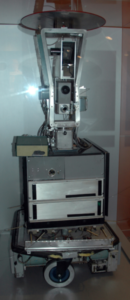
In the late 1960s, a groundbreaking project was underway at the Stanford Research Institute (SRI) in Menlo Park, California. This project was centered around Shakey the Robot, an ambitious endeavor that would come to be known as the world’s first general-purpose mobile robot. Shakey wasn’t just a machine; it was a vision of the future, a pioneer in artificial intelligence and robotics. Its story is a tale of innovation, challenges, and the quest to imbue a machine with the ability to think and perceive.
Shakey was a tall, wheeled robot equipped with a camera, a range finder, and bump sensors. It was named for its rather wobbly and shaky movement. However, what set Shakey apart from any machine before it wasn’t its physical capabilities but its intellectual ones. Shakey was designed to operate autonomously, making its own decisions based on its understanding of its surroundings. It could navigate complex environments, identify objects, and perform tasks without direct human control.
The brain of Shakey was a computer that processed information from its sensors and executed commands based on a series of algorithms. These algorithms allowed Shakey to perceive its environment, plan its actions, and learn from its experiences. It was one of the first attempts to apply artificial intelligence to physical movement and problem-solving in a real-world context.
Shakey’s creators set out to achieve several goals with this robot. They wanted to demonstrate that a machine could analyze and understand its environment, plan its actions, and navigate independently. They also sought to develop a platform for experimenting with and advancing the field of artificial intelligence. Shakey was, in many ways, a mobile laboratory, a testbed for theories and algorithms that would shape the future of robotics and AI.
The challenges facing Shakey and its team were immense. The computing power of the time was a fraction of what’s available today, meaning Shakey had to operate with very limited resources. Its sensors and motors were primitive by modern standards, and the field of artificial intelligence was still in its infancy. Despite these hurdles, Shakey made significant strides. It could navigate rooms, push objects, and even plan a series of actions to achieve simple goals.
While Shakey was a technological marvel, its real impact was in the field of AI research. Shakey’s development led to several advances in computer science, including new algorithms for problem-solving, path planning, and machine perception. These developments laid the groundwork for future generations of robots and AI systems.
As technology advanced, Shakey’s limitations became more apparent. It was slow, clumsy, and limited in its capabilities. Newer robots were faster, more agile, and equipped with better sensors and more powerful computers. Shakey, for all its groundbreaking work, was destined to become a historical artifact rather than a practical tool.
Today, Shakey is remembered as a pioneer, the forefather of intelligent automation. Its legacy can be seen in the robots that explore other planets, perform complex surgeries, and navigate warehouses, roads, and skies. Shakey’s story is a reminder of the humble beginnings of our most advanced technologies and the long, challenging journey from concept to reality.
Reflecting on Shakey’s story, we see more than a robot; we see a turning point in our relationship with machines. Shakey represented a shift from viewing robots as tools to seeing them as partners, capable of understanding, decision-making, and autonomous action. It’s a testament to human ingenuity and the relentless pursuit of knowledge. As we continue to push the boundaries of what machines can do, Shakey the Robot stands as a symbol of the first steps on the path to a future where robots and humans collaborate, explore, and learn together.